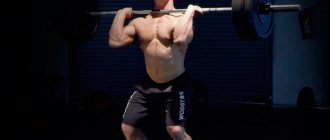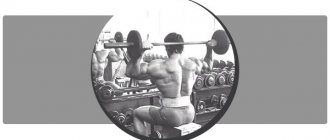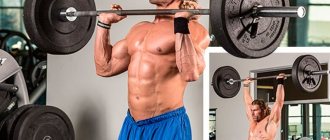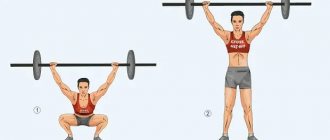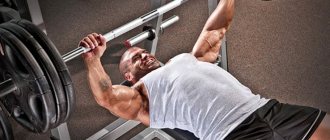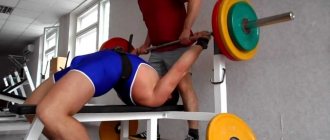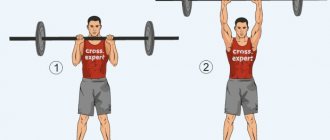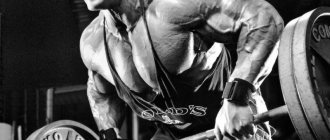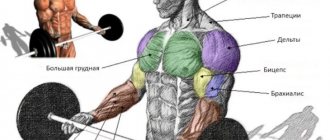Share:
What you need
- Barbell
- Platform
The squat clean is a universal exercise that involves almost all muscles. Such a popular trend as CrossFit breathed a second life into the exercise. In CrossFit it is used with light weight for a large number of repetitions and with heavy weight for 1-3 lifts.
The gluteus, hamstrings and quadriceps receive most of the load. The lower back, along with the above, plays an important role in performing the exercise.
The exercise can be classified as a speed-strength, technical exercise. Technology requires a lot of attention. At the beginning, take care of the production in a competent manner of execution. Break this exercise down into sub-exercises. Jumping is best trained with push and pull movements; at the end of each repetition, try to jump a little. Grooming techniques should be worked on with classic exercises such as the push, jerk and snatch. To successfully perform this exercise, you must squat with a barbell on your chest. There is a formula that many athletes adhere to, a weight with which you can squat frontally 3 times, it’s quite possible to take it to your chest and push.
Deadlifts help accelerate the barbell. By practicing this movement additionally, you will not have problems performing a squat clean. In such a type of load as the clean, a lot depends on coordination. Take time for a good warm-up. Warm up your elbows, knees and lower back. The success of the training directly depends on the preparation of the central nervous system and the musculoskeletal system for work.
Benefits and what muscles work
The barbell clean is one of those heavy exercises, thanks to which an athlete can significantly increase such indicators as strength, endurance, reaction speed, as well as the mass and volume of several muscle groups.
As a result, it is possible to increase working weights in other exercises.
The barbell jerk also provides the necessary aerobic exercise, develops coordination of movements, and promotes the body's production of testosterone.
Due to the stress that the muscles experience, they give maximum muscle response, and their growth becomes more active.
Article on the topic: “Push-ups on rings”
When doing a barbell clean, the main load falls on the following muscles and muscle groups:
- Gluteal.
- Quadriceps.
- Thigh biceps.
- Deltoid and trapezoid.
- Spinal extensors.
A considerable load also falls on the abdominal muscles, which serve as a stabilizer of the body position.
Benefits of exercise
Correct execution of the exercise allows you to maximally load several muscle groups in a short time and develop explosive strength.
- The muscles receive noticeable stress, provoking its active growth.
- Progress appears in performing other strength exercises.
- Speed and coordination of movements develops. Increases flexibility in the shoulder joints.
In other words, if classic barbell squats, deadlifts, or presses aren't enough for you, try this heavy exercise to get maximum muscle response. However, remember that lifting the barbell to the chest is quite traumatic and therefore requires refined technique. Therefore, it is better to start mastering the movement with an empty bar or light weight.
The exercise is contraindicated for problems with the spine, shoulder or knee joints, or wrist injuries.
Execution technique
Cleaning a barbell on the chest is a rather traumatic exercise, so the correct technique plays a vital role here. Its study will be facilitated by photos and especially videos that can be found in this article.
Lifting the barbell to the chest is performed in three stages: the barbell is torn off the floor, then thrown onto the chest and, finally, a squat under the barbell occurs.
Article on the topic: “Air squats”
Take starting position:
- The back is absolutely straight with a natural arch in the lower back (and it should remain that way at all times).
- The gaze is directed forward.
- legs with feet pressed tightly to the floor should be shoulder-width apart so that the center of gravity falls on the heels;
- The knees are apart.
- The bar itself should be located as close to the shin as possible (so that the toes are under the bar).
Keeping your back straight and your shoulders slightly back, squat down and with your straight arms grab the bar with a wide overhand grip. The bending angle of the knees is about 45°.
Lift the bar off the floor, trying to keep the bar close to your body - it should literally slide upward throughout the entire exercise.
While clearly controlling your movements, pull the projectile upward, creating sufficient inertia for the subsequent jerk.
When the bar is approximately mid-thigh, make a strong push almost from your knees and jerk the barbell onto your chest.
Article on the topic: “Sitaps: execution technique”
At the same time, fully straighten your legs and body to give greater acceleration to the rise, bring your pelvis forward slightly, and move your upper body slightly back (but just slightly).
While the bar is moving up, quickly perform a squat. At the same time, bring your elbows forward and down. The depth of the squat depends on the weight of the projectile: the larger it is, the deeper the squat, but in principle, the thighs should be parallel to the floor.
During the squat process, the acceleration of the barbell is dampened, and its bar ends up on the upper chest. The triceps are parallel to the floor.
Having completed the exercise in this way, you can either return to the rack, that is, to the starting position, placing the barbell on the floor, or lower it to the middle of the thigh and begin a new repetition (advanced athletes perform 8 repetitions in this way).
Jerk at competitions
In competitions, the clean and jerk is performed second, after the snatch. Not only the weight lifted is assessed, but also the correctness of the lift; for example, lifts are not counted if the athlete touched the platform with anything other than the feet (elbows, buttocks). Another common mistake that causes a failure is “pressing” the barbell (when the athlete first meets the barbell in the clean and jerk with slightly bent arms, and then straightens his arms).
Also, the approach will not be counted if the athlete did not fix the barbell and lowered it before the command was given to lower it.
Basic mistakes
Beginners often make a number of mistakes when performing this exercise. Here are the most typical ones:
- lack of warm-up, due to which the joints and ligaments are unprepared for the upcoming serious load, especially the joints of the elbow and hand, as well as the hamstrings;
- rounding of the back and lower back - even when using an athletic belt, it is necessary to control their position: the back should be straight, with a natural arch in the lumbar area;
- the weight of the projectile is too heavy, which makes it impossible to technically perform this exercise correctly.
Sitting up from the floor
The vast majority of modern experts in the field of weightlifting are firmly convinced that the prevailing technique of cleansing the barbell today is almost the height of perfection:
“Improving technology means the process of its development (change) in historical terms. Thus, during the birth of weightlifting, the technique was very primitive. Subsequently, its improvement proceeded in two directions: a) coordination in the work of muscles in the support phases of lifting the barbell to the squat was improved; b) the methods of squatting changed in the direction of increasing their depth (half-squats were replaced by a diagonal, it was replaced by high “scissors”, which gradually changed - their depth increased, the “scissors” were replaced by a split leg). The second aspect of the evolution of technology, i.e. increasing the depth of the squat, today, we can safely say, has been completely exhausted: a squat with a deeper landing than the stand-up no longer exists" (L.N. Sokolov, "Some issues of improving the sports technique of weightlifters" - athletics",
However, some experts believe that the depth of the “squat position” when lifting the barbell to the chest can still be significantly increased: this increase in the depth of the squat, apparently, should occur due to the expansion of the placement of the feet and the lowering of the pelvis between them as close as possible to the platform - and this, they say, is certainly the only serious change that can still improve and improve modern technology.
However, in fact, the views described above are erroneous. Perfection is always directly related to rationality, economy, and cost minimization, but when using modern barbell cleansing techniques, there is no particular saving in the athlete’s strength or energy costs. On the contrary, when using the modern chest clean technique - especially within the framework of the “finally improved”, that is, its completely underestimated version - there is a completely senseless waste of the athlete’s strength and energy. This is clearly evidenced by the fact that the barbell loses its lifting height after the lift when using the modern version of the squat clean. That is, in the modern technique of lifting the barbell on the chest in a squat, the lowering of the barbell is initially provided for, from the highest point of approach to the point of its fixation in the squat.
As it seems to modern experts in the field of weightlifting, such a significant loss of lifting height is absolutely normal, inevitable and due to the enormous weight of the barbell itself. With shorter braking paths, there is simply no way to stop the barbell of the weight that the weightlifter lifts in the clean and jerk.
These ideas, of course, are also incorrect. During the chest clean, immediately following the chest clean, athletes, pushing the same barbell with the same “significant weight” into medium or even high “scissors” or “spreaders”, stop and decelerate it after sending it over a section of length only Andrei Chemerkin, in his victorious race in Atlanta, managed with just one centimeter of depreciation - and even then, perhaps, it was just the stacks of disks that swayed elastically downward). That is, it turns out that a barbell of maximum weight can be stopped without unnecessary loss of height acquired during the approach after acceleration.
What, then, are the real, true reasons for the traditional uneconomicalness of the squat rise, and what recipe for saving strength when using this lift am I going to offer in this text?
The real reason why today almost everyone squats the barbell with a huge loss of height is normal human thoughtlessness, closely related to equally normal conservatism. The weightlifters did not come to the squat clean immediately, that is, the path to this lifting technique was not fast - but straight forward, like the run of a ram to a new goal.
At first, as noted above, weightlifters lifted the barbell to the chest in a rack or half rack. And this method of lifting, naturally, requires the most powerful acceleration of the bar from below. A way to carry out such an acceleration was found: this is a common, now widespread lift, performed with a straight back, straight arms, quickly bringing the knees under the bar and powerfully tugging the bar with the hips. However, a correct, highly coordinated and effective lift is, unfortunately, a very difficult technical action, which not all weightlifters can perform at a high level. Accordingly, in the past, many weightlifters were constantly and acutely faced with the issue of compensating for insufficient power and the speed of their detonation by increasing the depth of post-detonation care. And then, in the weightlifting sections, deep lifting techniques such as low “scissors” and “spreading” were tested and massively mastered.
I must admit that this idea - the idea that the traditionally and universally practiced lifting is too strong - until recently did not clearly occur to me, that is, I was also by and large convinced that in this element of weightlifting lifts everything is close to perfection, to completeness, to completeness and that there is no point in changing here.
However, a couple of years ago I came to a local weightlifting competition (it was the Kazan championship among students) and saw the following picture there. Along with the guys who used the usual technique of chest lifting, there were very few technical guys at those competitions; most of the athletes were frankly weak both in strength and technical terms), a student took to the platform who used, on the one hand, not quite the usual, on the other hand, it is quite effective.
The question, however, is, of course, not at all in the magnitude of the result, but in the fundamental possibility of mass movement under the barbell of the maximum weight during a squat clean, provided that the depth of its lowering of the barbell is significantly reduced. In my opinion, this possibility is quite real. After all, for example, when doing a full squat snatch, the weightlifter’s body during the escape lowers relative to the barbell by a distance approximately greater than during a clean - and the barbell at the time this snatch exit is performed by highly qualified athletes only lowers relative to the platform. Once again: when performing a snatch The weightlifter’s body travels downward relative to the barbell a distance that is almost one and a half times greater than during a clean. That is, with one and a half times less lowering of the body (during a clean, compared to a snatch), the lowering of the barbell can also be very significantly reduced
Now we need to figure out which method of accelerating the projectile within the framework of this lifting concept (that is, lifting into a deep squat) is preferable: a deadlift with a slightly bent back or a traditional straight-back lift - but just a very weak one (by the way, from experienced athletes for a long time you can hear recommendations like “When doing a clean, don’t force yourself too much - this leads to unnecessary waste of strength”)? Or maybe the most energetically beneficial is this seemingly clumsy movement (this is a certain Kirill Pavlov from
Another important question arises: will all athletes be able to straighten their back quickly and without injury during the rapid transition from getting up to sitting down? Unfortunately, I don’t know the exact answer to this question. It is very possible that not all athletes will be able to use the proposed technique. However, on the other hand, the danger of this technique should not be exaggerated: not only individual ordinary weightlifters (like the student described above), but also some champions for a long time, with complete impunity, curved their backs for the sake of their health - for example, Kirzhinov and Vardanyan.
I repeat, such expenditure of energy should have been abandoned long ago; it is irrational.
Source
Guest
popularity: 0
rank: no
access: limited
Tips and tricks for implementation
First of all, about contraindications: due to the high risk of injury, this exercise is categorically not recommended if there are injuries, and the spine, shoulder/knee joints and wrists cause unpleasant problems.
Experienced trainers give the following recommendations, which will certainly be useful to beginners:
- when starting to master the exercise, it is better to use one bar or barbell with minimal weight;
- wrap your knees and elbows with elastic bandages to reduce the risk of injury;
- do not forget to warm up properly: triceps extensions, bench press, dumbbell lifts will help here; light weight front squats, seated extensions, etc.
- the movement of the bar should not occur vertically, but along the body;
- the exercise should be performed as a single whole, and not as three separate phases - the transition between them should be smooth, but you can start by practicing each phase separately;
- special attention should be paid to ensuring that all muscles and muscle groups involved work in a coordinated manner; If any group lags behind, it is necessary to engage in its development.
Add a comment Cancel reply
You must be logged in to post a comment.
Push in CrossFit
In CrossFit, this exercise and its derivatives - rack clean, squat clean, chest jerk - are part of many WODs.
For a small number of repetitions, the clean and jerk is performed on near-maximum weights - 70-80 percent of the maximum. For a large number of repetitions, take no more than 30-40% of the maximum.
I would like to note that if you do CrossFit, get your equipment from a weightlifting coach. It's very common to see CrossFitters tightening the bar with their arms or swinging their backs instead of using their legs. Lifting more or less decent weight using this technique is fraught with injury.
Exercise: Squatting the barbell
Overall rating: 0
| Main muscle: | Biceps hamstrings |
| Secondary muscles: | Gluteal muscles, Trapezius, Forearm, Lower back, Shoulders, Quadriceps, Calf muscles |
| Exercise type: | Olympic weightlifting |
| Equipment: | Barbell |
| Mechanical action: | Composite |
| Power Type: | Traction |
| Level: | Average |
Exercise: Squatting the barbell
Overall rating: 0
| Main muscle: | Biceps hamstrings |
| Secondary muscles: | Gluteal muscles, Trapezius, Forearm, Lower back, Shoulders, Quadriceps, Calf muscles |
| Exercise type: | Olympic weightlifting |
| Equipment: | Barbell |
| Mechanical action: | Composite |
| Power Type: | Traction |
| Level: | Average |
Execution options
- Hanging rise . This option does not allow you to work on the fall phase, but the back on it is activated automatically as soon as the bar is lowered in straight outstretched arms, and therefore the rise from the hang is easier;
- Rise from pockets . It is performed with straight outstretched arms and from the level of the pockets, the goal is to practice undermining and leg movements. This allows you to gain speed, but this variation is not recommended for people with problematic spines and protrusions in the thoracic region.
